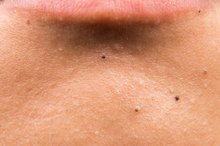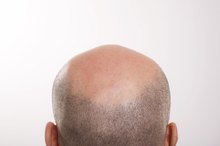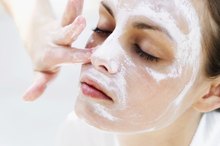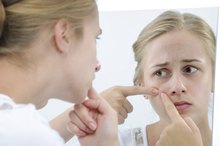What does fact checked mean?
At Healthfully, we strive to deliver objective content that is accurate and up-to-date. Our team periodically reviews articles in order to ensure content quality. The sources cited below consist of evidence from peer-reviewed journals, prominent medical organizations, academic associations, and government data.
The information contained on this site is for informational purposes only, and should not be used as a substitute for the advice of a professional health care provider. Please check with the appropriate physician regarding health questions and concerns. Although we strive to deliver accurate and up-to-date information, no guarantee to that effect is made.
How to Get Rid of Scars From Hives
It's rare for hives to cause any sort of scarring because hives don't typically lead to breaks in the skin, according the American Osteopathic College of Dermatology. Without this type of damage, the skin doesn't stimulate collagen production to repair the wound and thereby form scar tissue. However, hives can result in a condition known as post-inflammatory hyperpigmentation, which is often confused with scarring 2. Swelling left in the skin from the hives can encourage excess melanin to accumulate and result in small areas of discoloration thought to be a form of scar tissue.
Discuss your treatment options with a doctor or dermatologist. Medical professionals can assess the state of your skin to determine what needs to be done to remedy the condition.
How to Get Rid of a Nose Ring Scar
Learn More
Apply a thin layer of a topical corticosteroid to the areas of discoloration. This prescription medication reduces any residual swelling and stops the excess production of melanin. Spots eventually fade.
Cover the areas of discoloration with topical hydroquinone. This skin-bleaching agent is available in prescription and nonprescription strengths. It directly breaks up the clusters of melanin caused by the residual swelling, and spots eventually fade.
How to Get Rid of Freckles With Vitamin C
Learn More
Rub a topical lightener containing either azelaic acid or glycolic acid over the areas of discoloration. Sometimes these over-the-counter creams can lighten the spots left on the skin from hives, so check your pharmacy, grocery or another store for purchase.
Undergo a skin rejuvenation procedure. Chemical peels, dermabrasion and even microdermabrasion can all help to eliminate the areas of discoloration by stripping away the surface skin cells, which causes new skin to form that doesn't contain the excess melanin.
Tips
Before using any one of these treatment options, make sure the hives have healed on your skin. Antihistamines, such as diphenhydramine, chlorpheniramine, desloratadine and hydroxyzine, or prescription corticosteroids are used to reduce inflammation, redness and itching associated with this skin condition.
Corticosteroids are sometimes combined with hydroquinone and retinoids to reduce the swelling and encourage cellular turnover, which can speed the fading process.
Related Articles
References
- Mayo Clinic: Hives and Angioedema
- Skin Sight: Post-inflammatory Hyperpigmentation
- Decker A, Graber EM. Over-the-counter Acne Treatments: A Review. J Clin Aesthet Dermatol. 2012;5(5):32-40.
- Davis EC, Callender VD. Postinflammatory hyperpigmentation: a review of the epidemiology, clinical features, and treatment options in skin of color. J Clin Aesthet Dermatol. 2010;3(7):20-31.
- Fabbrocini G, Annunziata MC, D'arco V, et al. Acne scars: pathogenesis, classification and treatment. Dermatol Res Pract. 2010;2010:893080. doi:10.1155/2010/893080
- Kubba R, Bajaj AK et al. Postinflammatory Hyperpigmentation in Acne. India Journal of Dermatology, Venereology and Leprology. 2009;75(7):54.
- Sharad J. Glycolic acid peel therapy - a current review. Clin Cosmet Investig Dermatol. 2013;6:281-8. doi:10.2147/CCID.S34029
- Sarkar R, Arora P, Garg KV. Cosmeceuticals for Hyperpigmentation: What is Available? J Cutan Aesthet Surg. 2013;6(1):4-11. doi:10.4103/0974-2077.110089
- Sofen B, Prado G, Emer J. Melasma and Post Inflammatory Hyperpigmentation: Management Update and Expert Opinion. Skin Therapy Lett. 2016;21(1):1-7.
- Leyden J, Stein-gold L, Weiss J. Why Topical Retinoids Are Mainstay of Therapy for Acne. Dermatol Ther (Heidelb). 2017;7(3):293-304. doi:10.1007/s13555-017-0185-2
- Bandyopadhyay D. Topical treatment of melasma. Indian J Dermatol. 2009;54(4):303-9. doi:10.4103/0019-5154.57602
- Decker A, Graber EM. Over-the-counter Acne Treatments: A Review. J Clin Aesthet Dermatol. 2012;5(5):32-40.
- Mohamed Ali BM, Gheida SF, El Mahdy NA, Sadek SN. "Evaluation of Salicylic Acid Peeling in Comparison with Topical Tretinoin in the Treatment of Postinflammatory Hyperpigmentation." Journal of Cosmetic Dermatology. 2017 Mar;16(1):52-60.
- Sarkar R, Parmar NV, Kapoor S. "Treatment of Postinflammatory Hyperpigmentation With a Combination of Glycolic Acid Peels and a Topical Regimen in Dark-Skinned Patients: A Comparative Study." Dermatologic Surgery. 2017 Apr; 43(4):566-573.
- Shokeen D. "Postinflammatory Hyperpigmentation in Patients with Skin of Color." Cutis. 2016 Jan;97(1):E9-E11.
Writer Bio
Based in Minneapolis, Minn., Dana Severson has been writing marketing materials for small-to-mid-sized businesses since 2005. Prior to this, Severson worked as a manager of business development for a marketing company, developing targeted marketing campaigns for Big G, Betty Crocker and Pillsbury, among others.







